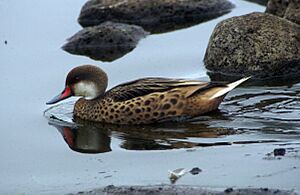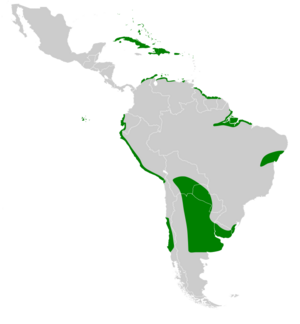White-cheeked pintail facts for kids
Quick facts for kids White-cheeked pintail |
|
|---|---|
 |
|
| Anas bahamensis galapagensis | |
| Conservation status | |
| Scientific classification | |
| Genus: |
Anas
|
| Species: |
bahamensis
|
| Subspecies | |
|
|
 |
|
The white-cheeked pintail (Anas bahamensis) is a cool type of dabbling duck. People also call it the Bahama pintail or summer duck. A famous scientist named Carl Linnaeus first described this duck way back in 1758. He gave it its scientific name, which it still has today.
Contents
Where Do White-Cheeked Pintails Live?
These ducks live in warm places like the Caribbean islands, South America, and the famous Galápagos Islands. They like to live near water that is a bit salty. You can find them in places like brackish lakes, which are lakes with some salt. They also live in estuaries, where rivers meet the sea, and in mangrove swamps.
Different Types of White-Cheeked Pintails
There are three main types, or subspecies, of the white-cheeked pintail:
- A. b. bahamensis: This one is called the Lesser Bahama pintail. It lives in the Caribbean. Sometimes, it flies to southern Florida.
- A. b. rubirostris: This is the Greater Bahama pintail. It lives in South America. These ducks might migrate, meaning they fly to different places. They breed in Argentina and spend winter further north.
- A. b. galapagensis: This is the Galápagos pintail. It lives only in the Galápagos Islands.
What Does a White-Cheeked Pintail Look Like?
Both male and female white-cheeked pintails look very similar. This is common for ducks that live in warmer southern areas. They are mostly brown with bright white cheeks. Their bill (beak) is grey with a red base. Young ducks have a completely black bill. It's easy to spot them because no other duck in their home areas looks quite like them!
How Do White-Cheeked Pintails Behave?
White-cheeked pintails are dabbling ducks. This means they feed by tipping their bodies forward in the water. They keep their tails up and their heads down to reach food. They eat water plants like Ruppia, grass seeds, and algae. They also snack on small creatures like insects and tiny water bugs. These ducks build their nests on the ground. They hide their nests under plants, always close to water.
White-Cheeked Pintails as Pets
These ducks are quite popular in collections of wild birds. Sometimes, they escape from these collections and live freely in places like Europe. There's even a special type called the silver Bahama pintail. It looks whitish because of a genetic change called leucism.
Gallery
-
Two white-cheeked pintails on the Island of Santa Cruz in the Galápagos Islands
-
Taken in the Galápagos Islands










